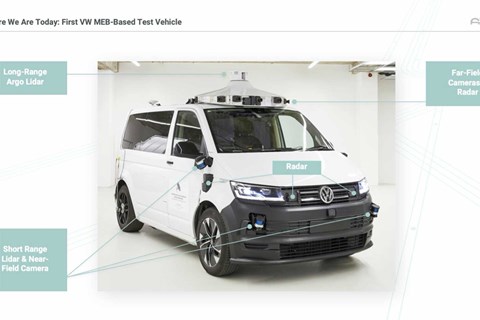► VW's autonomous plans revealed
► First trials on European roads
► Using the ID Buzz
Driverless electric Volkswagens are gearing up for deployment on European roads, as the continent’s biggest car maker steps up development ahead of a planned commercial introduction in 2025 – with no human at the wheel.
By the end of 2021, prototypes of the ID Buzz – the electrified reincarnation of the famous Kombi van, rolling on Volkswagen’s electric MEB architecture – will be testing on Munich’s streets, as well as on a purpose-built test track near Munich airport.
Volkswagen is prioritising development in its van division, as it sees commercial applications for autonomous vehicles – ride-hailing and delivery vehicles – providing a far stronger business case than passenger cars. That said, Volkswagen plans to extend Level 4, hands-off autonomous driving to cars in the ID electric range by 2026.
What’s the latest on driverless Volkswagen vehicles?
Volkswagen and its lynchpin autonomous partner, America’s Argo AI, have just begun the first European tests of this prototype, using the body of the T6 Transporter van atop the MEB electric platform. Only one of these autonomous prototypes will be built; it’s the ID Buzz that will constitute the fleet of test vehicles once in production later this year.
The partnership has begun racking up experimental miles at its Munich test facility, a 10-mile circuit mirroring European road infrastructure, with an emphasis on city driving. The facility will be able to run tests for right-hand-drive vehicles and it features roundabouts.
The T6 (pictured below) is laden with sensors to help the car see and build a comprehensive picture of its operating environment. The most obvious is the growth on the roof, which houses far-field cameras and radar in its base, and is crowned by what the Americans describe as their breakthrough enabler technology, Argo LIDAR.

LIDAR that can detect a spot of light 400 metres away
LIDAR stands for Light Detection and Ranging, and crudely speaking it bounces a laser off objects to detect how far away they are and build up a 3D picture of the surrounding environment. Argo claims its LIDAR is leading-edge because it operates up to 400 metres away, supposedly further out than rivals’, and can detect dark objects reflecting only a single photon of light, even at night.

But the LIDAR is only part of the T6’s suite of sensors. ‘Also positioned around the perimeter are near-field cameras, short-range LIDAR and radar,’ says Argo AI chief exec Bryan Salesky. ‘We believe it makes sense to use all three modes, as the strengths of one type of sensor complement the weaknesses in other types.’
Combining all those sensors helps build a high-resolution picture of the surroundings, from which Argo’s developers are writing software algorithms to ‘see, detect, sense and predict hundreds of thousands of objects on the road at once,’ claims Salesky. Volkswagen vows the computerised decision-making will take place at a local level in the vehicles, rather than be dependent on cloud-based operations that could be vulnerable to delays.
Time to invest in Argo AI?
Some big names in car-making certainly believe Argo is a potent tech company: Ford and Volkswagen have announced a $2 billion investment in its operations. Indeed Ford is a founding partner of Argo’s longer-established US operations, including a test track in Pennsylvania complete with rain and fog generators and highway speed testing.
Ford and Argo are also running tests in Michigan, California, Texas, Washington DC and Florida. Miami is a development hotspot for Ford and could be for Volkswagen Stateside: its warm climate isn’t vulnerable to sensor-fooling snow, and America’s seventh biggest city has a densely-populated centre suitable for trialling ride-hailing or autonomous pizza deliveries. Operating areas will also have to be rigorously mapped in high-definition.
Stuart Rowley, president of Ford of Europe, told CAR how Ford and VW’s joint investment will scale-up Argo. ‘[Our combined] large investment gives that venture huge reach globally when you think of Ford and Volkswagen. Ford’s initial focus is in North America, Volkswagen’s scale in Europe tops ours, and gives Argo a great opportunity.
‘For Ford, we’re focusing on the US first and then coming to Europe in time as we develop the technology, but clearly for Argo [the VW agreement] gives them big positions to operate in both regions.’ It’s also why Ford has signed a deal to produce vehicles on VW’s MEB electric platform – its electronic architecture is being fully integrated with Argo’s autonomous tech.
And tell me more about the business case...
Volkswagen reckons the autonomous commercial fleet market will be worth €500 billion over this decade. And moving people and goods is centralised in urban areas: VW calculates 10 western cities make up 50% of the market for these services.
‘The core of a city is where the demand is, where the [ride-hailing] trips are,’ explains Argo’s Salesky. ‘This is where we can build great businesses in both ride hailing and goods movement.’

‘With commercial vehicles, Volkswagen is already in a business providing services,’ says Christian Senger, head of VW vans’ mobility and transport as a service. ‘It’s logical that we are focusing on the pinnacle of the self-driving, Level 4 technology, where no steering wheels is necessary and the vehicle needs to be capable for all situations in a defined driving zone.
‘The only difference to Level 5 autonomy is that we work in a defined operating zone, whereas Level 5 would mean it works all over, for example, Europe under all conditions. But this is far away.’
Senger continues: ‘The next big step is going live with our ID Buzz, with the right autonomous driving technology. It's about being super strong in 360˚ sensor technology, with high-definition mapping, and cutting-edge, top-performance computing. It’s a huge data science challenge creating [autonomous vehicles] safer than even a human driver.’